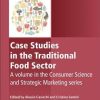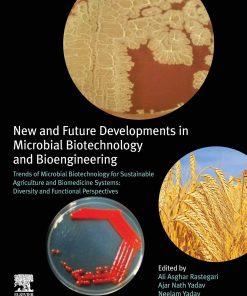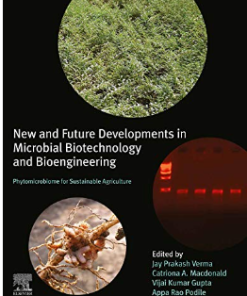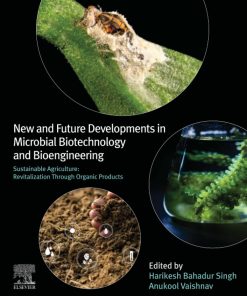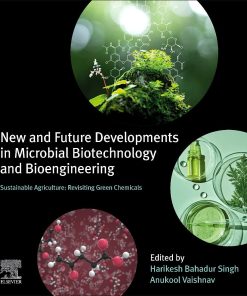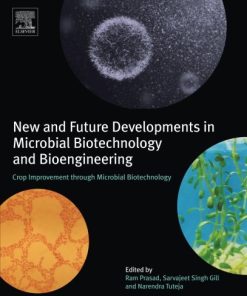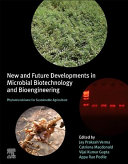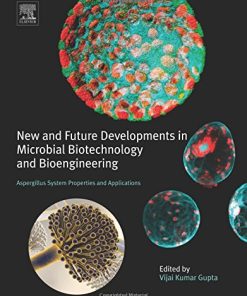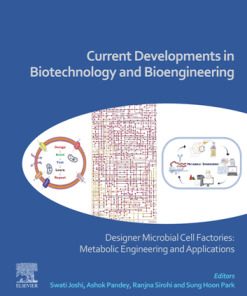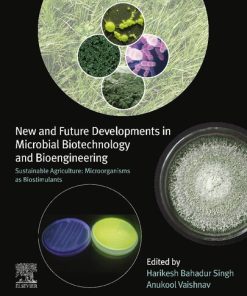(Ebook PDF) New and Future Developments in Microbial Biotechnology and Bioengineering Microbial Secondary Metabolites Biochemistry and Applications 1st edition by Vijai Gupta 0444635114 9780444635112 full chapters
$50.00 Original price was: $50.00.$25.00Current price is: $25.00.
New and Future Developments in Microbial Biotechnology and Bioengineering: Microbial Secondary Metabolites Biochemistry and Applications 1st edition by Vijai G. Gupta – Ebook PDF Instant Download/DeliveryISBN: 0444635114, 9780444635112
Full download New and Future Developments in Microbial Biotechnology and Bioengineering: Microbial Secondary Metabolites Biochemistry and Applications 1st edition after payment.
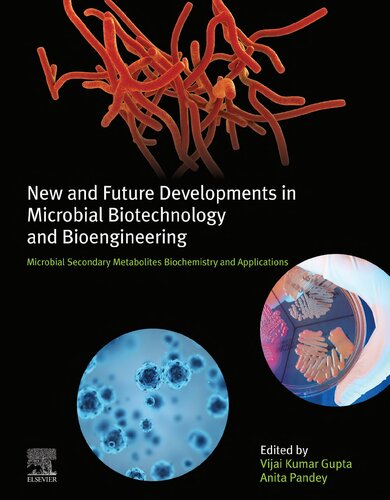
Product details:
ISBN-10 : 0444635114
ISBN-13 : 9780444635112
Author : Vijai Gupta
New and Future Developments in Microbial Biotechnology and Bioengineering: Microbial Secondary Metabolites Biochemistry and Applications examines the areas of biotechnology and chemical engineering, covering aspects of plants, bacteria and machines, and using microbes as factories. The book is aimed at undergraduates, post-graduates and researchers studying microbial secondary metabolites, and is an invaluable reference source for biochemical engineers working in biotechnology, manipulating microbes, and developing new uses for bacteria and fungi. The applications of secondary metabolites in biotechnology, pharmaceuticals, diagnostics and medical device development are also extensively covered.
New and Future Developments in Microbial Biotechnology and Bioengineering: Microbial Secondary Metabolites Biochemistry and Applications 1st Table of contents:
Chapter 1. Wild Mushrooms as Functional Foods: The Significance of Inherent Perilous Metabolites
Abstract
1.1 Introduction
1.2 Mushroom and Its Taxonomy
1.3 The Toxins and Their Perilous Connections
1.4 Prospects and Concerns in Terms of Human Health
1.5 Mushrooms as Dietary Supplements
1.6 Protein Composition
1.7 Lipid Composition
1.8 Carbohydrates and Fiber content
1.9 Mineral Composition
1.10 Conclusion
References
Chapter 2. Genetic Manipulation of Secondary Metabolites Producers
Abstract
2.1 Introduction
2.2 Genetic Engineering of the Secondary Metabolic Pathway in Plants
2.3 Secondary Metabolites in Actinomycetes by Metabolic Engineering
2.4 The Aspergillus nidulans MAPK Module and Secondary Metabolism
2.5 Conclusions and Future Scope
Acknowledgment
References
Chapter 3. Role of Rhizobacterial Secondary Metabolites in Crop Protection Against Agricultural Pests and Diseases
Abstract
3.1 Introduction
3.2 Early Uses of Biocontrol Methods in Agriculture
3.3 Microbial Secondary Metabolites
3.4 Rhizobacterial Secondary Metabolites and Biological Control
3.5 Regulation of Secondary Metabolites’ Production
3.6 Microbial Metabolites and Biopesticides Development
3.7 Concluding Remarks
References
Chapter 4. Bioengineering of Secondary Metabolites
Abstract
4.1 Introduction
4.2 Gene Duplication in Idiophase
4.3 Evolution of New Pathways
4.4 Bioengineering of Terpenoids in Plants
4.5 Metabolic Engineering and Microbial Biogenesis of Plant Isoprenoids
4.6 Enzyme Engineering
4.7 Conclusion
Acknowledgment
References
Further Reading
Chapter 5. Advances in Microbial Technology for Upscaling Sustainable Biofuel Production
Abstract
5.1 Introduction
5.2 Biomass Feedstocks for Biofuels Production
5.3 Downside of First- and Second-Generation Biofuels
5.4 Metabolic Engineering and Biofuel Production
5.5 Metabolic Pathways for Alcohol-Derived Fuels
5.6 Metabolic Pathways for Isoprenoid-Derived Fuels
5.7 Metabolic Pathways for Fatty Acid-Derived Fuels
5.8 Synthetic Biology and Its Role in Design of Microbial Cell Factories
5.9 Engineering Microbes for Tolerance to Next-Generation Biofuels
5.10 Conclusion
References
Chapter 6. Bioprospecting Actinobacteria for Bioactive Secondary Metabolites From Untapped Ecoregions of the Northwestern Himalayas
Abstract
6.1 Introduction to Secondary Metabolites
6.2 Introduction to Actinobacteria
6.3 Distribution of Actinobacteria
6.4 Choice of Actinobacteria as Source of Bioactive Secondary Metabolites
6.5 Actinobacteria From Unusual Environments
6.6 Northwestern Himalayas as Sources of Bioactive Actinobacteria
6.7 Conclusion
Acknowledgment
References
Chapter 7. Microbial Metabolites: Peptides of Diverse Structure and Function
Abstracts
7.1 Introduction
7.2 Antimicrobial Peptides
7.3 Classification of Microbial AMPs
7.4 Mechanism of Action
7.5 Potential Applications of AMPs
7.6 Conclusion
References
Further Reading
Chapter 8. Agrobacterium rhizogenes Mediated Hairy Root Cultures: A Promising Approach for Production of Useful Metabolites
Abstract
8.1 Introduction
8.2 Agrobacterium and Ri T-DNA Genes
8.3 Role of rol Genes
8.4 Secondary Metabolite Production
8.5 Large-Scale Production of Hairy Roots
8.6 Liquid-Phase Bioreactors
8.7 Gas Phase Bioreactors
8.8 Hybrid Bioreactors
8.9 Parameters That Affect Productivity
8.10 Conclusion and Future Prospects
References
Chapter 9. Unleashing Extremophilic Metabolites and Its Industrial Perspectives
Abstract
9.1 Introduction
9.2 Marine Microbial Metabolites Derived From Benthic Environment
9.3 Marine Sponge—Microbial Symbionts
9.4 Stromatolites: Potential Novel Source for Future Biotechnology
9.5 Polyhydroxyalkanoate-Producing Free-Living Marine Bacteria
9.6 Stress Acclimatization of PHA-Producing Bacteria
9.7 Production of Polyhydroxyalkanoate by Halophilic Bacteria
9.8 Role of PHA Synthase in Halophiles
9.9 Concluding Remarks
References
Further Reading
Chapter 10. Hybrid Bioactive Products and Combinatorion Biosynthesis
Abstract
10.1 Introduction
10.2 Need of Combinatorial Biosynthesis
10.3 Precursor-Directed Combinatorial Biosynthesis
10.4 Enzyme-Level Combinatorial Biosynthesis
10.5 Pathway-Level Combinatorial Biosynthesis
10.6 Conclusion
Acknowledgment
References
Chapter 11. Rubromycins: A Class of Telomerase Inhibitor Antibiotics Produced by Streptomyces spp.
Abstract
11.1 Introduction
11.2 Telomeres, Telomerase, and Cancer
11.3 Rubromycins: A Class of Molecules Telomerase Activity Inhibition
11.4 Mode of Action of Rubromycins Human Telomerase Inhibition
11.5 Streptomyces spp.: The Biofactories for Human Telomerase Inhibitors Production
11.6 Biosynthesis of Rubromycins
11.7 Bioprocess of Rubromycins Production
References
Chapter 12. Regulation by Metal Ions
Abstract
12.1 Introduction
12.2 Regulatory Mechanisms
12.3 Role of Specific Molecules in Controlling Biosynthetic Pathways
12.4 Metal Ions in the Synthesis of Organic Acids
12.5 Metal Ions in the Synthesis of Siderophores
12.6 Metal Ions in the Synthesis of Microbial Pigments
12.7 Metal Ions in the Synthesis of Vascular Permeability Factor
12.8 Metal Ions in the Synthesis of Hydrogen Cyanide
12.9 Conclusion
References
Chapter 13. Citric Acid Cycle Regulation: Back Bone for Secondary Metabolite Production
Abstract
13.1 History
13.2 Citric Acid Cycle: Process and Regulation
13.3 Citric Acid Cycle as Biosynthetic Precursors
13.4 Example of Synthesis of Metabolites Through Intermediates of Citric Acid Cycle
13.5 Conclusion
References
Chapter 14. Resistance in Pathogenic Microorganisms
Abstract
14.1 Resistance in Bacteria
14.2 Resistance in Fungi
14.3 Antifungal Resistance From Environmental Origin
14.4 Resistance in Viruses
References
Chapter 15. Hybrid Approach for Transformation for Betulin (an Anti-HIV Molecule)
Abstract
15.1 Background of Betulin
15.2 Main Sources of Triterpenes
15.3 Applications
15.4 Value Addition Using the Hybrid Approach
15.5 Key Strategies for Adding Value
15.6 Hybrid Approach to Develop Betulin Derivatives
15.7 Issues in Chemical Synthesis
15.8 Conclusion
Acknowledgments
References
Further Reading
Chapter 16. Producers of Bioactive Compounds
Abstract
16.1 Introduction
16.2 Bioactive Compounds
16.3 Major Classes of Bioactive Compounds
16.4 Criteria for the Selection of an Ideal Bioactive Compound
16.5 Diverse Biological Activities of Bioactive Compounds
16.6 Sources of Bioactive Compounds
16.7 Plants as the Sources of Bioactive Compounds
16.8 Invertebrates as the Sources of Bioactive Compounds
16.9 Microbial Producers of Bioactive Compounds
16.10 Bacteria as Producers of Bioactive Compounds
16.11 Fungi as Producers of Bioactive Compounds
16.12 Algae as Producers of Bioactive Compounds
16.13 Conclusion
References
Chapter 17. Bioremediation of Organic and Inorganic Pollutants Using Microalgae
Abstract
17.1 Introduction
17.2 Inorganic Pollutants
17.3 Organic Pollutants
17.4 Role of Biosurfactants in the Bioremediation
17.5 Emerging Pollutants
17.6 Conclusion
References
Further Reading
Chapter 18. Secondary Metabolites From Endophytic Fungi and Their Biological Activities
Abstract
18.1 Introduction
18.2 Endophytic Fungal Diversity
18.3 Secondary Metabolites
18.4 Conclusions
References
Chapter 19. Regulation and Role of Metal Ions in Secondary Metabolite Production by Microorganisms
Abstract
19.1 Introduction
19.2 Manganese
19.3 Copper
19.4 Nickel
19.5 Calcium
19.6 Cadmium
19.7 Zinc
19.8 Cobalt
19.9 Iron
19.10 Rare-Earth Elements
19.11 Other Metals
19.12 Conclusion and Future Prospect
References
Further Reading
Chapter 20. Metabolic Engineering to Synthetic Biology of Secondary Metabolites Production
Abstract
20.1 Introduction
20.2 Secondary Metabolites-Producing Microbes
20.3 Discovery of Novel Microbes Producing Secondary Metabolites
20.4 The Functional Genomics of Secondary Metabolites-Producing Microbes
20.5 Biodiversity of Secondary Metabolites-Producing Microbes
20.6 Distributions of Secondary Metabolites-Producing Microbes
20.7 Synthetic Biology for Secondary Metabolites Production
20.8 Biotechnological Applications of Secondary Metabolites
20.9 Conclusion and Future Prospects
Acknowledgment
References
Chapter 21. Microbial Enzymes as Control Agents of Diseases and Pests in Organic Agriculture
Abstract
21.1 Introduction
21.2 Production of Microbial Enzymes
21.3 Enzyme Purification
21.4 Role of Enzymes in Inducing Plant Resistance to Insect Attack
21.5 Antioxidant Enzymes
21.6 Types of Enzymes and Their Application in Agriculture for Pest Control
21.7 Final Conclusion
References
Further Reading
Chapter 22. Secondary Metabolites: Metabolomics for Secondary Metabolites
Abstract
22.1 Introduction
22.2 Secondary Metabolites and Synthetic Biology
22.3 Primary Metabolites
22.4 Secondary Metabolite
22.5 Genome and Genomics
22.6 Proteome and Proteomics
22.7 Synthetic Biology
22.8 Metabolomics and Synthetic Biology: How to Engineer the Microbes
22.9 Discovery of Secondary Metabolites: How to Discover Secondary Metabolites Through Metabolomics
22.10 Production of Secondary Metabolites
22.11 Role of Metabolomics in Identification of the Bottleneck in Engineered Pathway
22.12 Conclusion and Future Perspectives
Acknowledgments
Conflict of Interest
References
Chapter 23. Solid-State Fermentation Strategy for Microbial Metabolites Production: An Overview
Abstract
23.1 Introduction
23.2 History of SSF
23.3 Common Characteristics of Solid-State Fermentation
23.4 Analysis of Substrate Selection for Solid-State Fermentation
23.5 Microorganisms and Growth Kinetics for Solid-State Fermentation
23.6 Physicochemical Parameters for Solid-State Fermentation
23.7 Bioreactor for the Solid-State Fermentation
23.8 Conclusion
People also search for New and Future Developments in Microbial Biotechnology and Bioengineering: Microbial Secondary Metabolites Biochemistry and Applications 1st:
future biotechnology examples
future developments in technology
latest developments in biotechnology
is there a future in biotechnology
new developments in biotechnology
Tags:
Future Developments,Microbial Biotechnology,Bioengineering,Microbial Secondary,Metabolites Biochemistry,Applications,Vijai Gupta
You may also like…
Biology and other natural sciences - Biotechnology
Biology and other natural sciences - Microbiology
Engineering - Bioengineering
Biology and other natural sciences - Biotechnology
Science (General)
Biology and other natural sciences - Microbiology
Biology and other natural sciences - Biotechnology
Biology and other natural sciences - Biotechnology



